The Samsung Galaxy S7 and S7 edge Review: Part 2
by Joshua Ho on July 5, 2016 8:00 AM ESTCamera Architecture and UX
In general, camera has become probably the single biggest point of differentiation between smartphones at this point. As smartphones are often the only camera that most people carry on a day to day basis, the rear camera on a smartphone really cannot be a disappointment relative to the competition. While we can talk about how much a front-facing camera matters in terms of quality, it’s pretty safe to say that for photos and videos that are worth saving will be taken with the rear-facing camera.
While post-processing and a number of other factors are going to have a huge impact on the overall camera experience, the foundation that makes it possible to deliver a great camera is always going to start at the hardware.
| Samsung Galaxy S Cameras | ||||
| Galaxy S6 Galaxy Note5 |
Galaxy S7 | |||
| Front Camera | 5.0MP | 5.0MP | ||
| Front Camera - Sensor | Samsung S5K4E6 (1.34 µm, 1/4.1") |
Samsung S5K4E6 (1.34 µm, 1/4.1") |
||
| Front Camera - Focal Length | 2.2mm (22mm eff) | 2.1mm (21mm eff) | ||
| Front Camera - Max Aperture | F/1.9 | F/1.7 | ||
| Rear Camera | 16MP | 12MP | ||
| Rear Camera - Sensor | Sony IMX240 Samsung S5K2P2 (1.12 µm, 1/2.6") |
Sony IMX260 Samsung S5K2L1 (1.4 µm, 1/2.6") |
||
| Rear Camera - Focal Length | 4.3mm (28mm eff) | 4.2mm (26mm eff) | ||
| Rear Camera - Max Aperture | F/1.9 | F/1.7 | ||
In the case of the Galaxy S7, Samsung has done something that I thought they’d never do, which is move backwards in resolution in order to improve pixel sensitivity. In the case of the Galaxy S7, Samsung has moved from the Sony IMX240/Samsung S5K2P2 to the Sony IMX260/Samsung S5K2L1 sensor, with a 1.4 micron pixel size relative to a 1.12 micron pixel pitch in the previous generation. This means that there’s a 56% increase in sensitivity per pixel. Assuming the same process technology, this does improve low light performance significantly. While to some extent it’s true that improved CIS (CMOS image sensor) technology can alleviate the downsides of smaller pixels, on the same technology you have to reduce your fill factor/active sensor area. The other problem is that while read noise on the sensor does reduce per pixel as you reduce pixel size, the overall sensor read noise trends upwards. This means that the region in which the CIS noise is primarily limited by shot noise is going to be smaller as you reduce pixel size. Shot noise is an unavoidable reality of existence, to the extent that even our eyes can see this “visual snow” if ambient light is sufficiently dim.
However, in the case of the Galaxy S7 I suspect that there’s more to the story, because the dual pixel AF system means that for each 1.4 micron pixel each pixel needs two photodetectors. In order to make phase detection work, there has to be sufficient spatial separation to make this system work properly, so some of the benefit of these larger pixels will inevitably be eaten up in order to enable PDAF that works in basically all lighting conditions.
The other notable change here is that the Galaxy S7 uses an even wider f/1.7 aperture. Unfortunately, in Samsung's efforts to try and make the module thinner they've made the focal length slightly shorter than before which results in an effective focal length of 26mm. This and the wider aperture could lead to compromises as light is entering the optics at a more extreme angle than before.
With these basics covered, we can move on to a discussion of the user experience. While in the past it was easy enough to just take some still shots on a tripod, a holistic view of camera quality really needs to take into account far more than just the end result. A poorly designed camera application with low resolution, low frame rate preview, improper preview aspect ratio, poor control layout, and other issues can easily make it difficult, if not impossible to get the photo that you want. These issues are thankfully getting less common, but these problems can make it almost impossible to recommend a phone for its camera, no matter how good the results are.
In the case of the Galaxy S7, the camera application is a nice upgrade over the Galaxy S6 at launch, but for the most part nothing is really different this go around. I’m not going to spend too much time here, but the short story is that I don’t think that Samsung is doing anything wrong here, and things are pretty much as good as they’re going to get.
While leaving it at that would be enough, I want to recognize some of the improvements that Samsung has implemented here. The major improvement here is that Pro mode is finally useful, as this mode now allows for adjusting auto-exposure and AF targets, in addition to EV, shutter speed, ISO, white balance with 100K granularity, and manual focus. The one notable shortfall here is that Samsung only allows 800 ISO max in manual ISO mode when the true maximum is 1250. For better or worse though, that’s the only notable problem I encountered with the camera app itself. It’s easy to think that Samsung hasn’t done anything notable here, but this is more a testament to the execution of design more than anything else.
However, before we move on to image quality testing, we can take a look at our focus and capture latency tests. For those that are unfamiliar, this is a fairly simple test designed to see how long it takes for a phone to focus and capture a scene on our standard ISO test chart in good lighting conditions, which can give a fairly good idea for best case latencies.
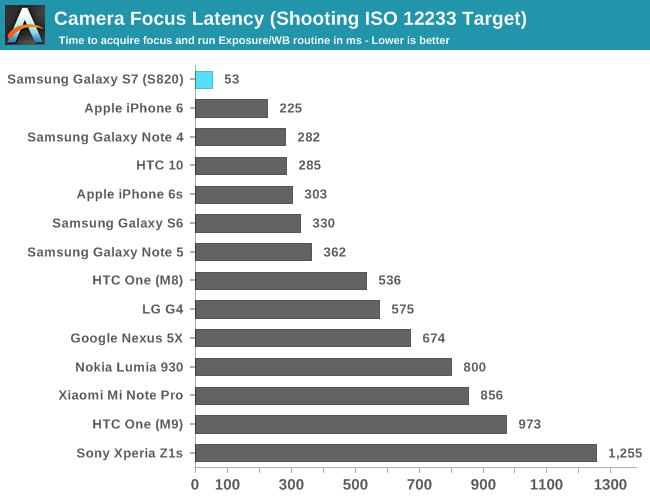
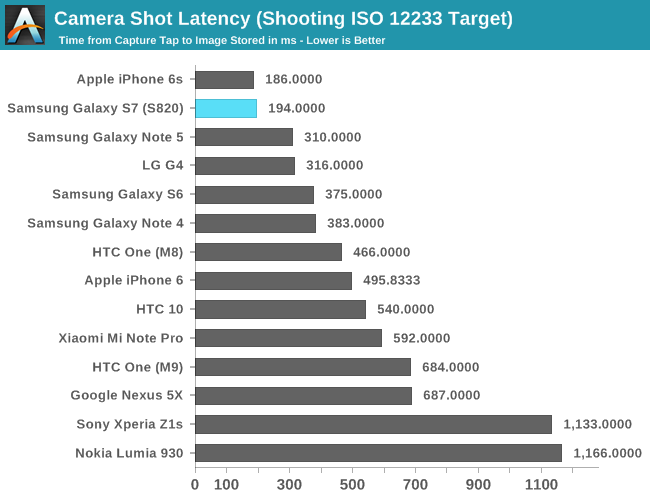
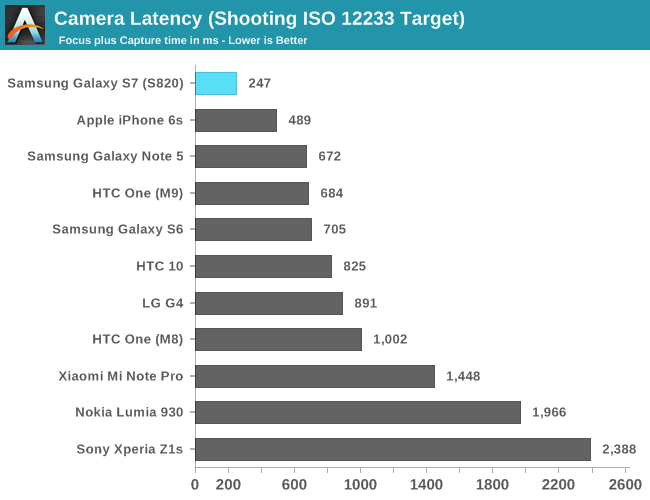
It’s probably not a surprise, but the Galaxy S7 is really, absurdly quick to take photos and focus. There is nothing out there that can realistically match the dual pixel AF system in the Galaxy S7, especially once you get into low light scenarios where traditional PDAF systems are overwhelmed by noise that can’t be easily canceled out. Samsung’s sheer prowess in semiconductor design and manufacture is really showing here, even in the best case.


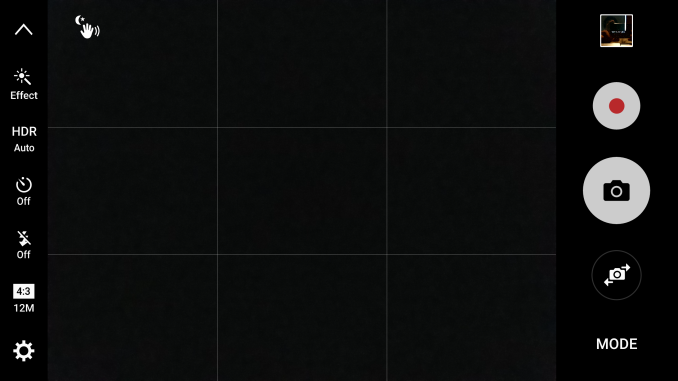
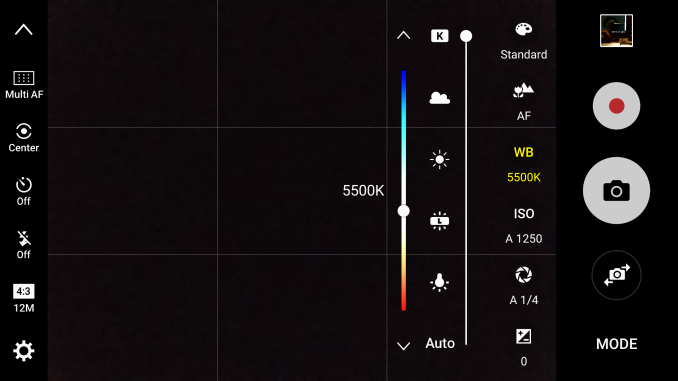
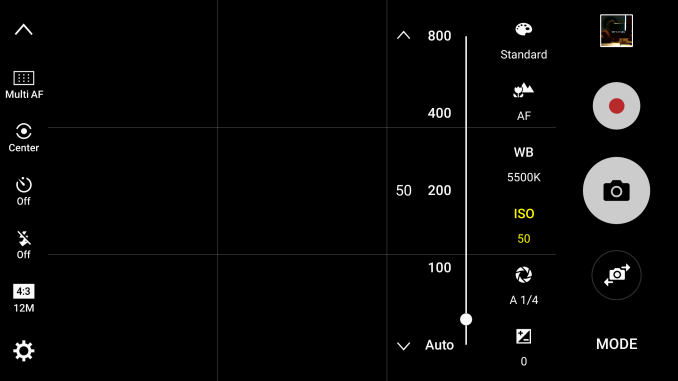








266 Comments
View All Comments
The Garden Variety - Tuesday, July 5, 2016 - link
From now on, Anandtech should first conduct a comprehensive survey of people's anecdotal experiences with a given product, and compare those anecdotes against their completed (but unpublished) review. Any instance where the anecdotes disagree with the un-published findings, those un-published findings should immediately be removed, or changed to reflect agreement with the consensus of anecdotes. Any refusal to do so, or immediately acknowledge the veracity of those anecdotes is a sign of bias, and the likelihood that great sums of money are changing hands behind the scenes becomes self-evident.There's no place for technology reviews that do not reflect consensus. None. To believe otherwise means you are part of the conspiracy and your opinions on all subjects are invalid.
MonkeyPaw - Tuesday, July 5, 2016 - link
I see what you're saying, but sometimes you have to question testing methodology. In my case, the LG G4 scores lower battery on wifi versus LTE. That goes against my personal experience, but it also goes against the long-standing expected results. By nature, wifi shoukd be better, as the phone is closer to source and disables mobile data to boot. Pointing this out should hopefully provide insight to AT.whiteiphoneproblems - Tuesday, July 5, 2016 - link
Haha -- um, I'm almost certain TGV is being sarcastic (as in their other great comments here).name99 - Tuesday, July 5, 2016 - link
Where's the usual comment complaining about one month and still no GTX 1080 review?Someone is slipping up!!!
Michael Bay - Wednesday, July 6, 2016 - link
I don`t see you shilling for crapple either!vyis - Tuesday, July 5, 2016 - link
I feel that this new review is a degradation compare to previous method.First of all, why do a in-lab like battery life measurement while disabling all the background services? There's a fare share of background service that should be left running to show differences in manufacturer control of background service (and samsung is particular bad at this)
On the GPU side, it's not an accurate statement for say SD820 won't do as well in game as A9. It depends on Game API and GPU design bias on type of raw processing core. On android, game developer may not code to harness the full potential of SD820 processing power. Apple did have upper hand as they straight down hardware to software control.
There's a mistake at camera section. "There is nothing out there that can realistically match the dual pixel AF system in the Galaxy S7, especially once you get into low light scenarios where traditional PDAF systems are overwhelmed by noise" Instead of PDAF, it should be contrast detection AutoFocus that struggle in low light.
For daylight still, samsung do have more sharping processing, however, 6s plus is not light on post-processing. In good lighting condition, 6s plus process away too much details. Without raw file i can't be sure type of processing being done. More over, s7 lens element is of sharper focus compare to 6s plus.
For low light still, i'm interested in all the 6s s7 comparison mention all over the article, just click into original file and see for yourself. For s6 and s7 comparison, it's hard to say without raw file. A different direction of post processing is being used.
Regardless, i can't agree that samsung have gone the direction of stronger noise reduction and sharpening. I can obviously see a much stronger noise reduction used on s6 low light still.
Video wise no comment. Sony digital image stabilization is best implementation on smartphone. Those tiny OIS on smartphone just making viewer sea sick.
Battery life, i do agree s7 is just ok. Sammy software have a problem in control background activity.
Impulses - Thursday, July 7, 2016 - link
Dunno whether you can really make any generalisation regarding PDAF vs CDAF in low light... If you go look at high end cameras, the best DSLR out there tend to AF pretty great in low light but not necessarily across the whole frame and not all high end DSLR are equally adept at it.Then you look at mirrorless bodies which traditionally rely on CDAF more heavily and there's a lot of them (even with smaller sensors like Panasic/Olympus) that can absolutely nail low light AF regardless.
Most of the mirrorless bodies are going with a hybrid approach anyway (largely for C-AF purposes, which falls well beyond what any phone is capable of), so yeah, I dunno... Seems like a pointless generalisation.
On a technical level Samsung's dual pixel AF seems pretty interesting, it's odd that it never saw the light of day in their larger sensors and NX system before they killed it off.
joex4444 - Tuesday, July 5, 2016 - link
Huawei, Xiaomi, and OnePlus are priced the way they are because they have next to no brand recognition. If they can start to prove a track record of quality phones that have demand, I would expect them to start selling for $600-$800 not $400.UtilityMax - Tuesday, July 5, 2016 - link
If Oneplus, like a decade later, finally earns a widespread brand recognition so it can charge some premium prices for its products, then some other startup manufacturer will take their place. In fact, sooner or later we're going to see a collapse of the prices of the big brand smartphones. We have already reached a "peak iPhone" in the sense that a LOT of people who are owning a three year old flagship smartphone will no longer be compelled to shell out 600-800 bucks for this years latest model. 200-300USD is already new normal for the mid-range smartphones. I just saw a brand new Moto G4 test phone at Best Buy, and that's how they're priced already.fanofanand - Wednesday, July 6, 2016 - link
This right here. Commoditization is taking place like in the PC space, and while there may be a few remaining "high-end" phones out there, the VAST majority of sales will come in the sub $400 space. With subsidies disappearing, fewer and fewer people will shell out $700-1000 for a new phone every year, or even every other year. Just taking a look at the mid-range phones in the $200-300 space, as you mentioned, yields a huge number of competent phones that will meet the majority of users needs. Apple is going to need a new trick to maintain it's profitability, which is probably why they are flinging things at the wall in desperation, i.e. the watch, the Apple Car, etc.